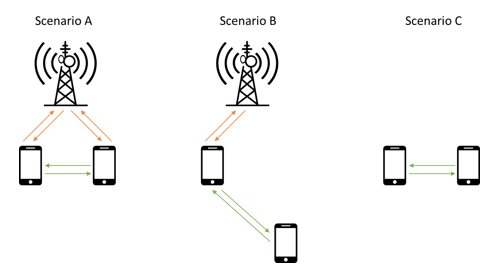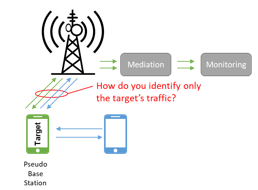Many have used the terms uplink and downlink and they may become more colorful when our video calls drop off. But are “uplink” and “downlink” the terms used?
No, for years there have also been “Sidelink” communications. That is, direct mobile-to-mobile communications, but without connecting to a telecom network. While it had modest beginnings, “Sidelink” has quickly become part of the most innovative 5G technology.
Uplink, Downlink and Sidelink
Uplink and downlink are used in different contexts, but generally mean the same thing. Uplink is the direction of communications from a device to the network core, and downlink is from the network core a device.
Sidelink however, is a direct proximity-based cellular connection. It is referred to as “direct” because it is between two devices. It is “proximity-based” because the two devices need to be within range of each other.
There are several reasons for enabling two (or more) devices to communicate without traversing the cellular network. For instance, there is much lower latency and also because it enables communications out of range of a base station. One thing to keep in mind however, by not traversing the cellular network, there is an impact to the lawful intelligence paradigm.
The concept of two or more devices forming a proximity-based and wireless connection is not foreign. We use them every day and an easy example is Bluetooth. Another is technically called Wi-Fi Direct. For Apple iOS users, Wi-Fi Direct is called Airdrop and Airplay. It goes by other names for gaming consoles, smart TVs, and Android smartphones. The benefits for devices to leverage Wi-Fi Direct are similar to those of Sidelink, it reduces latency and increases speed.
Sidelink Origin
The idea of Sidelink arose from the public safety sector. Imagine a scenario where disaster strikes and the general public simultaneously tries to connect via their mobile phones – leaving circuits unavailable or unreliable to safety professionals. Or the disaster may leave mobile base stations without power, or unable to connect to the network for voice switching. Perhaps, the impacted area never had cellular coverage in the first place. All these scenarios and more, drove the origination of Sidelink.
The specification for Sidelink was first provided in the 3GPP Release 12. At that time, Sidelink was referred to as “LTE D2D ProSE”. “LTE” because 4G LTE was the newest technology when Release 12 was published. “D2D” because it was device to device, and “ProSe” for proximity services.
At that time, there are three scenarios for which Sidelink was defined

- Scenario A, where the devices are all on the cellular network and the network is coordinating/optimizing.
- Scenario B, where a device that is connected to the cellular network acts as a “pseudo base station” for out-of-range devices.
- Scenario C, where the devices are on the cellular network.
Sidelink Today
While Sidelink was specified originally for LTE networks and for public safety applications, the device-to-device concepts have been incorporated into 5G innovations. Those innovations include autonomous vehicles, smart factories, smart cities and the Internet of Things (IoT). 5G is defined as being ultra-reliable and providing low latency mobile communications. This means it is intent on eliminating unnecessary communication connections or hops.
When two devices are directly connected using Sidelink, there are zero hops. When combined with the new radio spectrum of 5G, those “zero hop” connections can support significant bandwidth. This is the main reason Sidelink is gaining traction with smart cities, IoT and autonomous vehicles which leverage the communication methodology, cellular vehicle to everything (C-V2X).
According to Qualcomm’s OnQ blog, “C-V2X-enabled vehicles use a short-range direct-communication mode that provides 360° non line-of-sight (NLOS) awareness, complementing onboard line-of-sight (LOS) sensors such as cameras, radar, LiDAR, and others. This combination of wireless technology and onboard sensors enables C-V2X vehicles to see, hear, and anticipate potential driving hazards, even at blind intersections or in poor weather conditions.” For smart cities, IoT and smart factories there are similar benefits.
With significant speeds, coupled with extremely low latency, there’s a lot of interest in Sidelink technology. The FCC in the United States just allocated unlicensed spectrum for the C-V2X purpose. However, we’ve just scratched the surface of Sidelink applications. Before we go declaring a Sidelink national holiday, there are drawbacks, especially when it applies to lawful intelligence.
Sidelink’s Impact to Lawful Intelligence
In the paradigm of lawful intelligence, a network operator may be required to assist law enforcement in an investigation. The underlying assumption is all the communication traffic for a targeted device is flowing through a lawful intelligence platform that resides within the network. Additionally, it assumes it is possible to uniquely identify the traffic associated with a specific device.

All of the scenarios described in previous section have some communication data that does not traverse the cellular network and therefore, breaks the lawful intelligence paradigm. However, scenario B brings up two particularly interesting challenges.
Consider a situation where the target device is out-of-cellular-range (OCR) and is using Sidelink to access an in-cellular-range (ICR) device (acting as a “pseudo base station”). The first challenge is the network needs to be made aware of the situation to initiate communication interception. Without this, no data is intercepted (a.k.a., under-collection).
The second challenge is that the ICR and OCR device communication traffic are mixed. If there isn’t a means to uniquely identify the target device’s traffic, too much data is intercepted (a.k.a., over-collection). Under-collection means you’ve missed evidence and over-collection means the evidence may need to be discarded.
Additional Challenges for Lawful Interception
There are many new applications and innovative technologies that will enter the commercial and consumer space in the era of 5G. Sidelink is a natural fit for many of them. As discussed in the webinar How the Crime Scene is Being Disrupted with 5G, these services or technologies are often quickly adopted by criminals. So, while the nature of the technology makes it elusive for lawful interception of communications, criminal organizations will intentionally leverage it for nefarious activities. Law enforcement needs to have access to these communications in addition to those that move through the network, to ensure all data packets are captured for a targeted device.
Conclusion
The concept of having devices connect to each other without connecting to a network is not new – look at Bluetooth and Wi-Fi Direct. But how D2D communications are being embraced by cutting edge technologies is new.
Sidelink reduces the number of communication hops to zero. It takes advantage of the high bandwidth available in 5G’s new radio spectrum which makes for an ultra-fast, low latency connection. But not all D2D traffic will go over a telecom operator’s network and will therefore be outside the reach of lawful intelligence platforms.
Law enforcement agencies need to be aware of all communications channels they need to execute an investigation and regulators need to revisit the services for which they require telecom operators to assist. Ultimately, telecom operators will need to ensure that they are still in compliance with those regulations.
Ensure your organization is both compliant and keeping pace with emerging technology by contacting the SS8 team today.
About Kevin McTiernan

Kevin has over 20 years of extensive experience in the telecommunications and network security industries. At SS8, Kevin is the VP of Government Solutions and is responsible for leading the vision, design, and delivery of SS8’s government solutions, including the Xcipio® compliance portfolio. You can learn more about Kevin on his LinkedIn profile by clicking here.
About SS8 Networks
SS8 provides Lawful Intelligence platforms. They work closely with leading intelligence agencies, communication providers, law enforcement agencies and standards bodies. Xcipio® is already proven to meet the very high demands of 5G and provides the ability to transcode (convert) between lawful intercept handover versions and standard families. Intellego® XT is a monitoring center that includes MetaHub, a best-in-class data analytics tool for intercepted, 3rd party and location data. Both product portfolios are used worldwide for the capture, analysis, and delivery of data for the purposes of criminal investigations.


